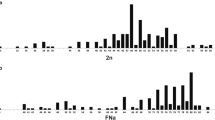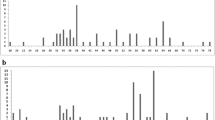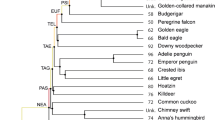Abstract
The extensive literature on the origin of the ratites focuses mainly on three questions: are the ratites mono- or polyphyletic, did they evolve from flying ancestors, and are they primitive or advanced? Opinion tends to accept a common descent from flying ancestors for the large ratites (for a summary of ideas see ref. 1). They would have evolved on Gondwanaland some time in the Cretaceous and have become dispersed over the southern continents after its fragmentation2,3. However, the position of the small New Zealand kiwis, in many respects the most peculiar of all birds, is still a matter for conjecture1,4. The chromosome complements of the large ratites have been found to be remarkably uniform5–8. The chromosome set of the kiwi, described here, clearly links up with these, which may be recorded as another indication for monophyly of all ratites. It also indicates that we are dealing here with very ancient karyotypes.
Similar content being viewed by others
References
Sibley, C. G. & Ahlquist, J. E. Bull. Peabody Mus. nat. Hist. 39, 1–276 (1972).
Fooden, J. Science 175, 894–898 (1972).
Cracraft, J. J. zool. Res. 169, 455–545 (1973).
Cracraft, J. Ibis 116, 494–521 (1974).
Sasaki, M., Ikeuchi, T. & Makino, S. Experientia 24, 1292–1293 (1968).
Takagi, N., Itoh, M. & Sasaki, M. Chromosoma 36, 281–291 (1972).
Takagi, N. & Sasaki, M. Chromosoma 46, 91–120 (1974).
Benirschke, R. J., Sekulovich, R. E. & Risser, A. C. Chromosome Inf. Serv. 21, 13–14 (1976).
Boer, L. E. M. de. Genen Phaenen 17, 1–115 (1974).
Boer, L. E. M. de. Genetica 46, 77–113 (1976).
Hennig, W. Phylogenetic Systematics (Urbana University Press, 1966).
Gorman, G. C. in Cytotaxonomy and Vertebrate Evolution (eds Chiarelli, A. B. & Capanna, E.) (Academic, London, 1973).
Lucca, E. J. de. Revue Bras. Pesquisas méd. Biol. 7, 253–263 (1974).
Author information
Authors and Affiliations
Rights and permissions
About this article
Cite this article
de Boer, L. Do the chromosomes of the kiwi provide evidence for a monophyletic origin of the ratites?. Nature 287, 84–85 (1980). https://doi.org/10.1038/287084a0
Received:
Accepted:
Issue Date:
DOI: https://doi.org/10.1038/287084a0
- Springer Nature Limited
This article is cited by
-
Comparison of the Z and W sex chromosomal architectures in elegant crested tinamou (Eudromia elegans) and ostrich (Struthio camelus) and the process of sex chromosome differentiation in palaeognathous birds
Chromosoma (2007)
-
The molecular basis of chromosome orthologies and sex chromosomal differentiation in palaeognathous birds
Chromosome Research (2007)
-
A novel family of repetitive DNA sequences amplified site-specifically on the W chromosomes in Neognathous birds
Chromosome Research (2006)
-
Chromosome reshuffling in birds of prey: the karyotype of the world's largest eagle (Harpy eagle, Harpia harpyja) compared to that of the chicken (Gallus gallus)
Chromosoma (2005)
-
The compositional patterns of the avian genomes and their evolutionary implications
Journal of Molecular Evolution (1993)





